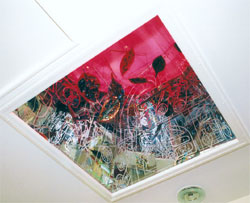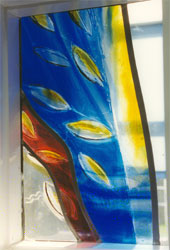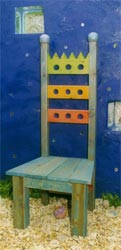Gloucestershire County Council
Public Art Strategy Pack
Support within the Capital Strategy Framework
Gloucestershire County Council has produced a Public Art Strategy Pack in the form of a card folder which has images of projects achieved over the last five years and text on the background, aims and achievements of the Strategy to date. Seven illustrated inserts describe case studies showing a variety of different approaches.
The text of the folder and a summary of the case studies follows below, or alternatively, the illustrated card folder and two of the case studies can be downloaded by following the link.
The full pack can be obtained from:- Helen Owen, Arts Development Officer, Gloucestershire County Education Service, Colwell Arts Centre, Derby Road, Gloucester, GL1 4AD.Tel: (01452) 544049; Fax: (01452) 550539; E-mail: [email protected]
Update: October 2006
After ten years each contemporary work of art commissioned by Gloucestershire County Council, whether as an integral part of a structure or landscape or not, will be subject to a formal review. The Council have kindly given us permission to add their review procedure here.
Follow this link to download the Public Art Policy / Percent for Art Policy Review Procedures as an Adobe Acrobat document: 54KB
Follow this link to download the illustrated Public Art Strategy Pack folder as an Adobe Acrobat document: 3.98 MB
Follow this link to download case studies 4 and 7 as an Adobe Acrobat document: 850KB
To be able to open these documents you must have the Adobe Acrobat reader. If you do not have Adobe Acrobat follow this link to download it for free.
Follow this link to find out more about Acrobat Reader document accessibility features.
Reproduced by kind permission of Gloucestershire County Council.
County Council Public Art Strategy
Support within the Capital Strategy Framework
Background
Strategy and Resources Committee 1 July 1998 agreed a Public Art Strategy for the County, with these aims:-
• to improve Gloucestershire's environment
• to stimulate the local economy through creating employment and developing skills
• to involve the local community through consultation and direct involvement in projects
• to contribute the County's Arts Strategy

Integrated mobile by Helen Turner, 2002
Lakefield School, Gloucs.
Photo: Martin Avery
The Council agreed to deliver the strategy through a Percent for Art levy* on the Council's capital programme, supplemented by a small top slicing of the capital budget of £40,000 pa. This funding has previously been targeted to projects by the Council's Percent for Art Officer group, in order to meet the Council's key priorities.
*Percent for Art is a policy whereby a small proportion of the capital budget for a project is used to commission new works by artists and craftspeople. Such works become part of the scheme, improving the built environment.
New Five Year Programme
In 2003-4, the Council reaffirmed support, and agreed a new five year programme of support. This promises to deliver:
• new programme of strategic creative commissioning
• leverage of new funds from external sources
• increased collaboration with Gloucestershire District Councils
• opportunities for County artists to learn new skills
Percent for Art will be considered for all appropriate Council capital projects with a value of over £300,000. The additional budget (£40,000 p.a.) will be used to target:
• projects in areas of need where members most want to see development
• involving artists in design collaboration to improve design quality and engage communities in development
• commissioned work in digital and other new technologies
What the funding has enabled
1. Improving Gloucestershire's environment
12 separate commissions within an overall programme of 22 projects, in a range of settings spread across the county. Projects have been targeted to areas to deprivation, contributing to the County Council's vision and service aims. At Hesters Way School, Cheltenham, funding enabled an artist to create an extraordinary enhancement - cast glass brick and coloured landscape theme - to an otherwise plain link corridor.

Stained glass by Mollie Meager, 1999
The Forum Youth Centre, Cirencester, Gloucs
Photo: Martin Avery
2. Stimulating the local economy
Over half the funding for the Percent for Art programme has come from the National Lottery or other external funding. Although the Council's first National Lottery funding award of £100,000 has now expired, further bids to help sustain the programme are in development. Drawing in this funding is reliant on seed funding from the Council's capital programme.
Of the 30 individual artists commissioned to date, 22 are county based (creating employment, developing skills etc.)
3. Involving the Local Community
All projects have included participation by the local community. A large number of have been in schools, involving pupils, staff and parents.
At Hesters Way School , the artist worked with all the children in the school, the staff and the family centre.
The Milestone School commission won a national award for excellence in the arts in schools this year. It was heavily reliant on GCC capital funding to enable it to work well in the context of the needs of children with severe learning difficulties. The work functions as a challenging but safe landscape for them, as well as being a work of art.
At Dunalley School, Cheltenham, the Secret Garden became a very successful and highly appreciated commission, addressing learning and literacy issues as well as being a work of art.

The Secret Garden, Tracy Hager, 1997/1999
Dunalley School, Cheltenham, Gloucs.
Photo: Martin Avery
4. Contributing to the County's Arts Strategy
Capital funding has enabled support of the Council's Best Value Review of the arts and subsequent Performance Improvement Plan. Key recommendations were to develop the public art programme, working more strategically with Districts and within the County Council, through joint commissions, guidance, advocacy seminars etc. The funding has helped us develop of a core of exemplar projects to use as a learning resource for others.
Capital funding enables
• Public Art commissions in relatively small scale projects which would not otherwise be able to afford artwork, but where there is particular strategic or community benefit. Project capital budgets are now so pared that this supplementary funding is essential.
• Developmental commissions, eg recent Digital Arts commission, designed to enhance local skills/awareness in the use of new technology.
• 10 year review programme of commissions, to ensure quality is maintained.
• Engaging artists at an earlier "concept" stage of design than would otherwise be possible, thus influencing good design.

Seat by Tracy Hager (fabricated Justin Croften and Jez Croften)
Dunalley School, Cheltenham, Gloucs.
Photo: Martin Avery
Addressing County Council priorities
The public art programme effectively meets Corporate Plan priorities and objectives for the environment, the local economy and learning. It meets capital strategy priorities since it
• Involves internal/external partnership working
• Addresses actions from a Best Value Review
• Draws in funding from non borrowing sources
• Gives environmental benefit
Helen Owen
Arts Development Officer
E-Mail: [email protected] Tel: (01452) 425079
PROJECTS SUPPORTED
All projects have included participation by the local community or, in the case of schools, by pupils, staff and parents.
Bishops Cleeve Library, 2002
Public façade of refurbished Library to be developed with adjacent Youth Centre and Grangefield School .
Churchdown Library, 2001
Glazing
Cirencester Traffic and Environmental Project, 2002
Planning Consultation and Design Development
Cotswold Water Park Spine Road , 2002
Artwork integrated into cycle path
Cotswold Way , 2002
12 original texts on small plaques
Digital Arts Project, 2001-2
Artist commissioned to initiate digital work with 6 artists throughout County
Dursley Library, 2003
Artist on planning team for new library
Forum Centre, Cirencester, 1999
Reception area and glazing
Hopebrook School, Forest of Dean. Spring 2003
Exterior, possibly entrance walk/bridge
Lakefield School, Frampton on Severn. 2002
Audio, mobile work and ceramic panels by children. Glazing.

Detail of window by Heather Marshall (2002) at Lakefield School, Gloucs.
Photo: Martin Avery
Milestone School, Gloucester. 2002
Sculptural landscape with planting
Nailsworth Cycle Path, 2002
New site and new design
CASE STUDIES FROM ACROSS A COUNTY
Public Art Practice in Gloucestershire
The following text summarises the six illustrated case studies in the Gloucestershire County Council Public Art Strategy Pack.
Introduction
These case studies are a response to requests from practitioners in Gloucestershire for examples of public art in practice. The studies are selected from a range of projects, and illustrate a variety of different approaches. Some were commissioned by Gloucestershire County Council; others by different commissioners, using different artists. We hope these short texts will help others to commission artists with confidence and success.
Policy into Practice
Cotswold District Council has adopted public art policy statements and a Percent for Art policy towards new social housing development, as part of a partnership agreement with four housing associations. Public art is addressed within the Authority's Social Housing Policy and a percent for art contribution is offered to housing associations, funded from a proportion of the sale of council house stock.
Cotswold District Council officers recognised that there was a skills gap for successful delivery of the policy, both within the Council and in housing associations. A Public Art Adviser was appointed, and a practical 'how to commission' pack has been produced including information on a pool of artists. The case study then outlines how housing associations are encouraged and supported to commission quality public art in their developments. Twelve commissions have been achieved to date. These include fencing, railings, gates, tiles, seating, etched windows and sculpture. A further eighteen commissions are underway and due to be installed before March 2004, these include artist-designed play surfacing, a 'human' sundial and bespoke chimney features.
Art on the Cotswold Way National Trail
Gloucestershire County Council is the lead authority for the Cotswold Way National Trail. The Trail Strategy has a chapter on the contribution which the arts can make to the enjoyment of walkers along the new trail. It states that: 'Work needs to be integrated at all stages, to be of a high standard and sensitive to local character. The importance of collaboration with communities, care in site selection and the need to be imaginative in public art is emphasised.'
Three deliberately varied pilot commissions were at the centre of the Strategy:-
- Travelling Light Theatre Company and Changing Places Environmental Arts Group worked for a week in each of four schools in the villages adjacent to Old Sodbury Hill Fort, resulting in a performance at the June solstice in 1998.
- A sculpture proposal by stone carver and calligrapher Bryant Fedden working with stone carver Matt Baker, resulting from a residency in a local school and a centre for people with learning difficulties. Local opinion was against the proposal, which was replaced by a series of seats with poetic texts in the courtyard of Chipping Camden Library.
- An open brief for an artist-led project. Tom Clark's proposal for a series of small plaques with texts sited on gates and stiles and referring to discrete views and details in the landscape was selected. Following development, the plaques are located in three woods owned by the Woodland Trust.
The study highlights the need for sensitivity when working in areas of outstanding natural beauty.
Cinderford Triangle
The Cinderford Triangle was the flagship project for the Cinderford Partnership, a local organisation set up to administer Single Regeneration Budget funding in the town. A design competition was held to improve this uninspiring town centre site. The winning scheme by Quattro Design included an open market hall structure, with stone tower, glazed retail kiosk and an open air amphitheatre. The proposal included work with a range of local artists to enhance the scheme.
Artist co-ordinator Sue Chudley was appointed to identify artists for the building elements including stone seating carved with local dialect words, paving and a clock. The public was involved through a design day, comments in a shop window display and through newspaper participation. It has taken time to overcome initial local scepticism about the town centre improvements, but the ambitious design has helped support regeneration.
Milestone School's 'Giant Stitches'
Gloucestershire County Council operates a 'Percent for Art' policy on key capital building developments. The Milestone School is the amalgamation of three special schools into one. The idea of commissioning an artist to use landscape as a sculptural opportunity came from discussions between the staff, architect and art consultant.
Artist Mike Fletcher designed a rippling earth work along the whole length of the school with ridges on which are planted silver birch trees. Furrows between the gentle slopes of the ridges carry pathways with images and mosaic inlays. The whole design creates the challenge and stimulus the staff had hoped for. The artist presented his design ideas to the staff and some parents and children, and was very well received. His proposal included workshops with the children to develop images for the pathway. The case study details construction problems and the impact this had on budgets. But the fraught construction phase produced a highly successful artwork which went on to win a prestigious national award.
The Minotaur and the Hare
Sophie Ryder's bronze sculpture, The Minotaur and the Hare, is located at one end of The Promenade, a busy shopping street in the middle of Cheltenham . The campaign to site it there involved an innovative partnership between a local authority, a voluntary body and the private sector.
The sculpture was initially brought to the town as part of a temporary exhibition in Cheltenham Art Gallery and Museum, and at locations around the town for which temporary planning permission was required. At the close of the exhibition, there was a move to purchase a Ryder sculpture for permanent siting. The fundraising appeal was made under the 'charitable umbrella' of the Summerfield Trust. The Borough Council was unable to contribute to the appeal, which had to look to public and private donations. The total was reached mainly with small pledges, and two major donations from a local family and from Beaufort Homes as part of a Section 106 Agreement for 'planning gain'. The sculpture is a much photographed part of the town's fabric.
Forest of Dean Sculpture Trust - Lightshift
The Forest of Dean Sculpture Trust is an independent charity working in partnership with Forest Enterprise, with a remit to commission original work by contemporary artists in the Forest of Dean. In the wake of the Foot and Mouth epidemic in 2001 which had closed the Forest, a number of local organisations were invited to propose ideas to help regenerate the area. The Sculpture Trust suggested an art-based illumination project to 'light up the forest'.
Lightshift was never conceived purely as an economic regeneration initiative but as a way of bringing a 'feel good' factor into the Forest, to put it on the map and to boost local confidence. With Sam Wilkinson as project co-ordinator and a team of six artists, 25 projects, using a wide range of technologies, were selected to be developed. The event was presented over seven nights in October 2001, attracting an audience of 40,000 people through word of mouth, mainly from the local area, and representing a broad spectrum of age, class, gender and race. Feedback from visitors was universally positive, and people cherished the opportunity to visit the Forest on a series of brilliantly clear, moonlit nights.
Hopebrook Primary School
Hopebrook Church of England Primary School is a new school designed by Quattro Architects, on a site in the village of Longhope, an amalgamation of two smaller schools. The artist, Jony Easterby, began to work with the schools in advance of the move to the new building, so that the project provided continuity during the transition. The amalgamation to two schools, staff teams and sets of pupils was a particularly sensitive context for the commission.
The brief was that the process of working with the artist, and the resulting artwork should have an on-going educational value. It was important that the work should be interactive and that the children should have strong sense of ownership. Jony Easterby devised a series of 'acoustic ecology walks' during a Creative Arts Week, encouraging the children to listen to their environment, and to use recording equipment to capture personal soundscapes. The arts week activities were seen by the teachers as contributing significantly to learning across a range of curriculum issues. This work with the children formed the basis for the designs for the sound garden which became the permanent legacy of the project. The artwork has played a significant role in establishing a conherent sense of identity and ownership of the new building.
